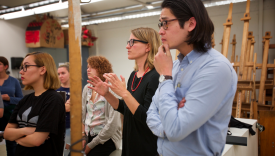Art & the History of Art 199 - Apocalypse and Utopia: Expressionist Art and Architecture
M/W | 2:00 PM - 3:20 PM
(Offered as ARHA 199 and ARCH 199) Expressionist art developed during moments of profound transformation and crisis, against a back drop of devastating wars and fears of an apocalypse, yet filled with utopian promise and radical dreams of a better existence -- a world in many ways not unlike our own. A literary, cinematic, architectural, photographic and visual art, Expressionism mined the tensions between alienation and empathy, matter and spirit, representation and abstraction, politics and community, the city and the natural world. Our investigations begin with early twentieth century artists like Edvard Munch, Wassily Kandinsky and E.L. Kirchner and the Dadaist works of Otto Dix and George Grosz, as well as photographers and artists associated with the New Objectivity such as August Sander and Kathe Kollwitz. We will also consider examples of early Expressionist film, and the phenomena of Expressionist architecture -- manifested in buildings, drawings, and imaginative environments. We will conclude with postwar artists such as Joseph Beuys, Asger Jorn and Eva Hesse; Abstract Expressionists like Jackson Pollock; and Neo-Expressionist artists such as Anselm Kiefer and Gerhard Richter. Our class will focus on original works of art in the Five College Museums, culminating in a student curated pop-up exhibition of newly acquired Expressionist drawings at the Smith College Museum of Art.
Limited to 25 students. Spring 2025: Professor Koehler.
How to handle overenrollment: Priority to ARHA and ARCH majors.
Students who enroll in this course will likely encounter and be expected to engage in the following intellectual skills, modes of learning, and assessment: Emphasis on historical and visual analysis, theoretical reading, research, presentation, and writing, including curatorial practice. Occasional field trips to the Smith College Museum of Art.


